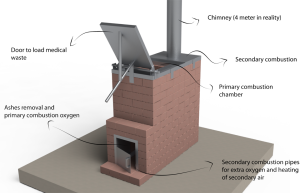Medical Incinerator
In the spring of 2014, Brecht built a high temperature incinerator for the NGO ‘Vivir en Amor’. They run a small clinic in the west of Guatemala and this incinerator provides them with a sustainable waste management solution. This way, they can safely dispose of their most toxic medical waste. Studies have shown that when garbage is burned at temperatures over 800 degrees Celsius, chemical toxins and pathogens such as PBT’s are broken down and rendered harmless. This is a major improvement to the hospital in Yalanhuitz.
Currently, garbage in Guatemala is either burned or put in a landfill. The problem with the current open air burning of trash is that it produces many pollutants, including but not limited to:
- Dioxins (PBT’S): Backyard burning is of particular health concern because it produces significant quantities of dioxins. Dioxins are classified as persistent, bio-accumulative, and toxic pollutants (PBTs). PBTs are highly toxic, long-lasting substances that can build up in the food chain to levels that are harmful to human and ecosystem health. Much of the dioxins created and released into the air through backyard burning settle on plants. These plants are, in turn, eaten by animals or humans, which store the dioxins in their fatty tissue. As a consequence, animals at the top of the food chain (such as humans) tend to have the highest dioxin concentrations in their bodies. Dioxins can alter the fundamental growth and development of cells in ways that have the potential to lead to many kinds of impacts. These include adverse effects upon reproduction and development, suppression of the immune system, disruption of hormonal systems, and cancer.
- Volatile organic compounds: People in the immediate vicinity of a burn barrel are also exposed to high levels of volatile organic compounds (VOCs) produced by open burning. Many VOCs are harmful to humans. Inhaling certain VOCs can lead to eye, nose, and throat irritation; headache; loss of coordination; nausea; and damage to heart, liver, kidney, and central nervous system.
- Ash: Backyard burning also produces ash residue, which can contain toxic metals such as mercury, lead, chromium, and arsenic. These metals can be toxic when ingested. When a person ingests hazardous amounts of lead, for example, he or she may experience high blood pressure, cardiovascular problems, kidney damage, and brain damage. Garden vegetables can absorb and accumulate these metals, if added to compost or soil, which can make them dangerous to eat. Children playing in the yard or garden can incidentally ingest soil containing these metals. Also, rain can wash the ash into groundwater and surface water, contaminating drinking water and food
The incinerator is a strong example of how to deal with toxic waste in a safe manner. It serves as a prototype for the region and as an educational proof of concept. Local craftsmen have been trained so they can build many more high temperature incinerators, not only in this one village but in many more villages in the region.
Money for this project has been raised through Wethetrees, Christian Shearer’s Permaculture fundraising website: http://www.wethetrees.com/campaigns/medical-incinerator-in-guatemala
 surpluspermaculturedesign
surpluspermaculturedesign